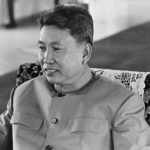This was an early 20th century nickname or expression facilely describing the ‘Action Squads’ or ‘Squadre d’Azione. These were ‘fascist’ paramilitary groups formed in Italy before 1920. They played a real part in the rise of Benito Mussolini (q.v.), recruited from war veterans, rebellious students (most 20th century students were naturally rebellious; in the 21st century they formed themselves into ‘trade unions’ – a bit of a misnomer since students either do not want to study, or will work but without sufficient attention to detail; the unions are supposed to be supportive of the wage-earning man or woman).
Recruits were also easily found among working class youth, though ‘working class’ is itself a misnomer, but one is not permitted to use the expression ‘lower-class’ as it might offend sensibilities. ‘Under-class’ is perhaps the best term best invented by the politically correct.
Ironically, these action groups were (and are) usually backed by industrialists, press magnates and the richer type of landowner, who liked nothing better than to kick any trade union movement in the face, as well as any actual or budding socialists they could discover.
The Biennio Rosso (1918-20) was a good example; these were two bloody years in which unemployed ex-servicemen, demobilized following the end of the Great War & not wishing anyway to take up work as agricultural labourers, caused bitter clashes in Tuscany and Emilia-Romagna and the industrial north-west of Italy. The people starved while the harvest rotted in the untouched fields. Industrialists feared an imitation of the Bolshevik Revolution, but Italian socialists and trade union leaders were loath to start one as they could never be sure it would be properly supported by the workers: Italy is not, after all, Russia.
The Action Groups went into action all right, terrorizing townspeople and villagers while the police and army did nothing to stop them. Left-wing newspapers and leftist political parties had their premises burned down, as well as those of the Catholic Peasant League (an easy target).
The violence unleashed by the ‘Blackshirts’ called that because their sartorial tastes ran to very dark shades of tunic, made it comparatively easy to bring Benito Mussolini into power, but he lost any control he might have had over them with the ‘March on Rome’ in 1922, when they allied themselves with local leaders he was quite unable to manage. Crying “I don’t give a damn’ (“Me no frego!”) they showed utter contempt for all authority. Then they seized Giacomo Matteotti, a socialist deputy in the Parliament and stabbed him to death. This was June, but his mutilated body (unfit to be approached) was not found until August. Mussolini and the Action Groups were blamed for the murder but the King (Victor Emanuel III), afraid of socialists and communists, refused to ask for his resignation. Meanwhile the Blackshirts went on the rampage across Italy and forced Mussolini to begin setting up a Fascist dictatorship in January 1925. The end for the Blackshirts came when Mussolini, eager to gain the support of industrialists, big landowners but above all the army and the monarchy, disbanded and disarmed the groups in October of that year. It was apparently much easier to perform such a task in the years leading to the Second World War. As world history has shown, it has been an infinitely more difficult – if not actually impossible – task to disband radical groups since 1945.










Leave A Comment